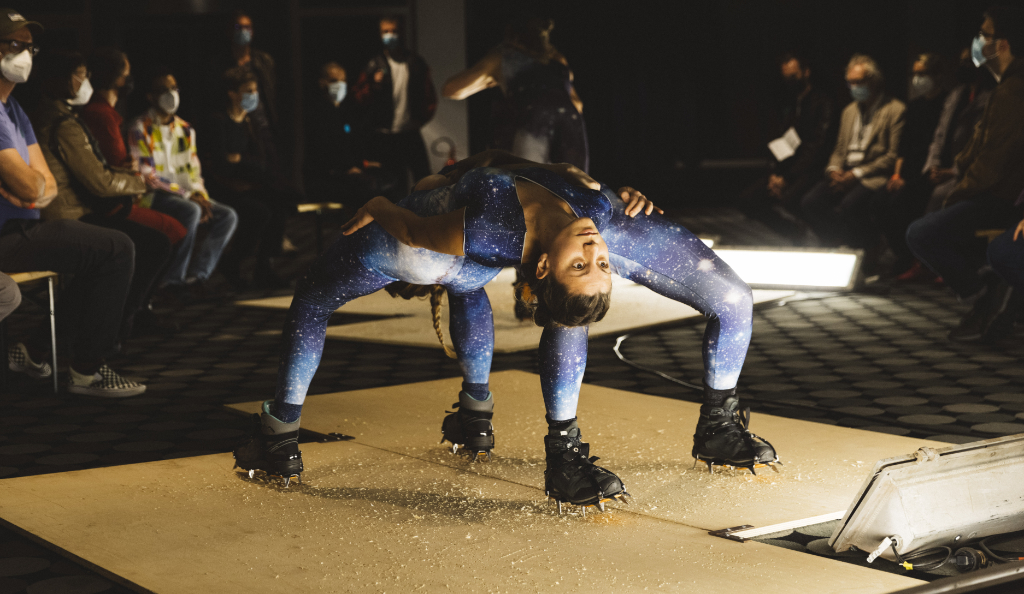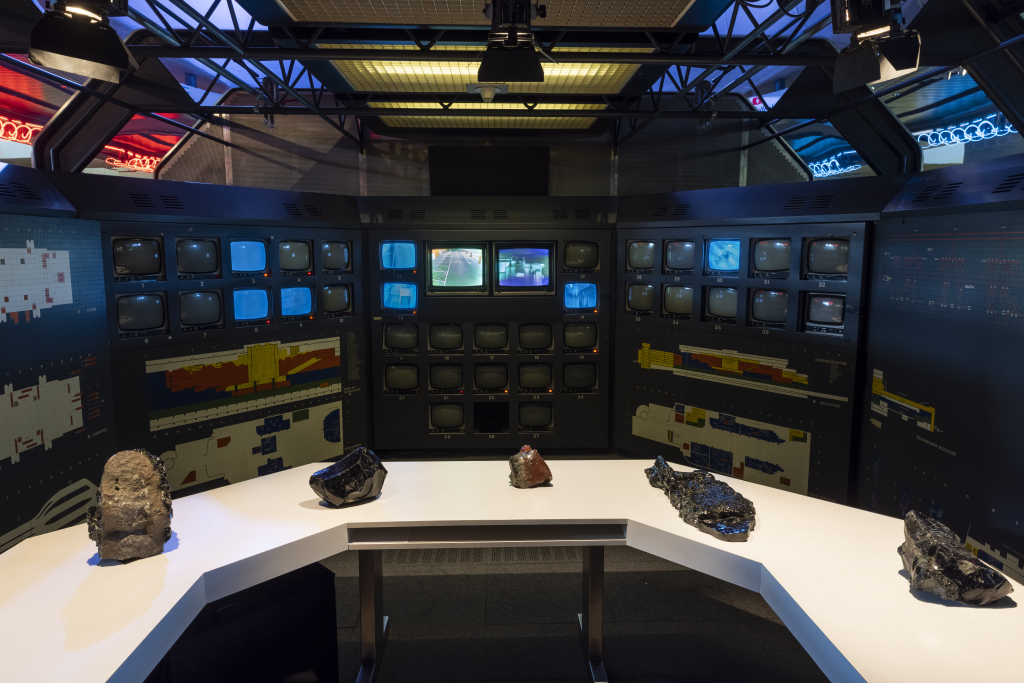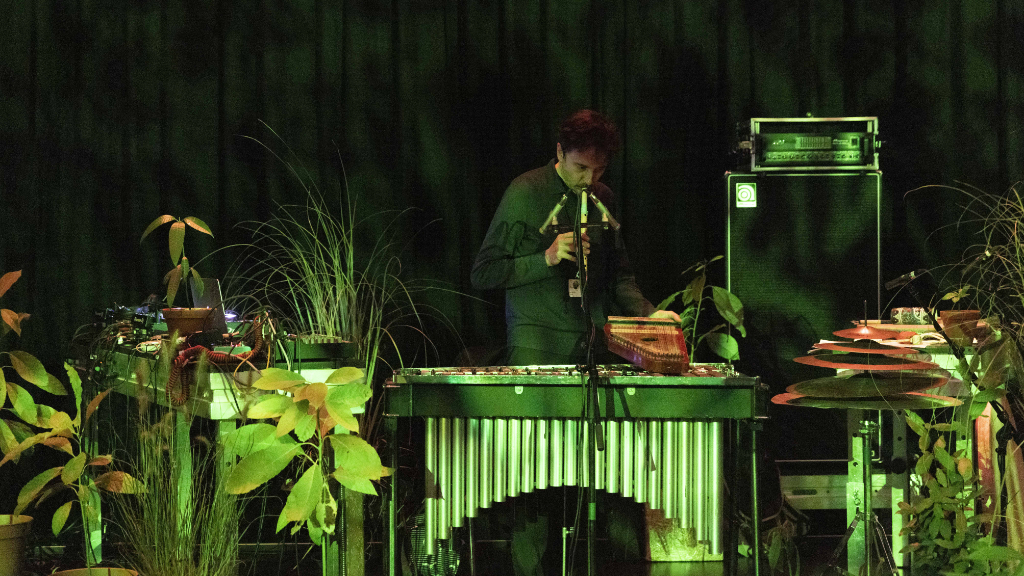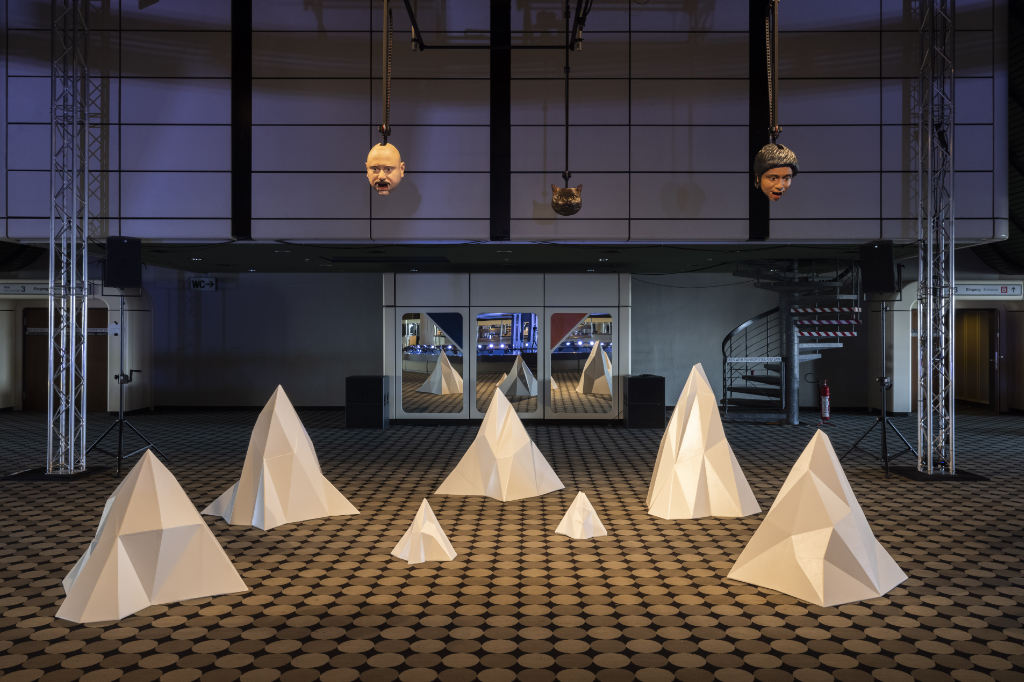Text by Leoni Fischer

The Sun Machine Is Coming Down!, reads the prophetic call filling my DM’s in a sudden gush. Over the last months, few messages spread as rapidly amongst the Berlin art scene as that of the temporary reopening of ICC- Berlin’s gigantic postwar techno-futurist Landmark- under the reign of art.
One day later, a stream of excitement descends on me as I stand in front of the complex that looks more like an alien spaceship or SciFi submarine – ready to take off or submerge any second. The spacious entrance hall unfolds, allowing an in-depth view of the giant iron belly. Maximalism seems to be the credo of the project, for which a large curatorial team has invited several big-name artists to revive the former convention centre. Navigating through the extensive and unhandy exhibition leaflet proofs was pointless after the first attempt, so I decide to indulge in the experience rather than viewing specific works.
Shiny escalators and dark, carpeted stairs go off to both sides of the hallway, hemmed by thin, light tubes flashing red and blue. Glass vitrines line up along the hall as I follow the neon arteries towards the heart of the building. Inside, artefacts that seem to originate from various ages and cultures enter an uncanny symbiosis within their terrariums that glow in the twilight. Some of these object assemblages by Markus Selg resemble ethnographic museum displays or a collection of contraband confiscated by customs featuring a somewhat extraterrestrial spirit. Nearby, a dusty advertisement behind glass creates a glitch in the surreal aura of the installation, drawing attention back to the building’s former use.
Cyprien Gaillard’s Suspire (for ICC’s control room) seems to purposely point to this interplay between the surreal atmosphere of the place and the down-to-earth politics behind its fate as an asbestos-contaminated structure. One finds crystalline formations made from mould asbestos in a small space near the entrance. Gaillard turned this toxic substance that once led to the closing of the building into strange rocks that appear like souvenirs from a distant planet. The fact that asbestos became widely used around the same time as the first successful moon mining event in 1972 – just a few years before the opening of the ICC – puts weight on the many associations sparked by the installation.



Right: From Its Mouth Came a River of High-End Residential Appliances, WangShui

Some walking minutes later, the middle part of the hall becomes covered by a scenography offering a feel somewhere between a shopping mall and an indoor barefoot path. At the centre of the Freeway Dance installation, artist Ayaka Nakama performs metamorphous movements with her tulle tutu. Although the environment is captivating, the performance’s official description online as a paradisiacal garden, (…) a place where the idea of monoculture is abandoned seems to clash with the artificiality of this zone, which appears more like the interior non-space counterpart to the freeway below.
Nevertheless, the installation creates the perfect stage for an ironically self-distancing look on the highly fashionable exhibition audience. Just as this thought crosses my mind, a man in a beige trench coat carrying a motorbike helmet on his arm enters the scene via the bark mulch path. Contemplating, I watch him water a hyper-green plant with great earnestness using a plastic spray bottle before he walks off vigorously as if he was about to attend an important meeting. Somehow the whole experience feels like a grotesque collective dance above the Berlin highway.
A different kind of dance awaits the viewer in hall ⅘, where two and later three interpreters, as Sehgal calls his performers, engage in This Joy. In contrast to Freeway Dance, the surrounding here is kept deliberately unagitated. Some waiting room kinds of sofas are spread throughout the small, fully carpeted room with low ceilings. Contrary to much of Sehgal’s work, where the relationship between everyday life and performance constantly fluctuates, the inconspicuously dressed interpreters can be quite easily detected as such by their singing.
Only the entry of the third performer, who at first sits down quietly among the audience, creates a moment of uncertainty. Nevertheless, observing their careful interplay remains a touching, almost bodily experience, reacting to each other through sung fragments and cautious movement. Much later, the composition reveals itself as a highly deconstructed version of Beethoven’s Ode to Joy.
Watching some visitor draw his phone from his pocket to point it at the performer, who is rolling her body meticulously across the floor right by his feet, I think again about the multifaceted modes (self-)distance and proximity inside this immersive heterotopia. As an amusing commentary, the performers start dancing around, chanting ‘This is so contemporary’ along with Beethoven’s melody. Thereby, they point as well to Sehgal’s piece from 2005 with the same name. Exiting the hall, I notice the artist watching from behind the darkened glass of the attached control room.
Back in the hallway, I get in line at one of the food stalls spread around the space. Three hours have passed in a flash, leaving me slightly overwhelmed and an unmanageable amount of work yet to be seen. Memories of art fairs and conventions come to mind standing on a white bar table and munching on a pretzel. As I look down on the nightly freeway, I fantasise about how it would feel to be sent to space in this iron time capsule, removed forever, surrounded by all the soothing oddities of the art world. And my mind hits play on Bowie’s Major Tom:
“For here
Am I sitting in a tin can
Far above the world
Planet Earth is blue
And there’s nothing I can do.”






